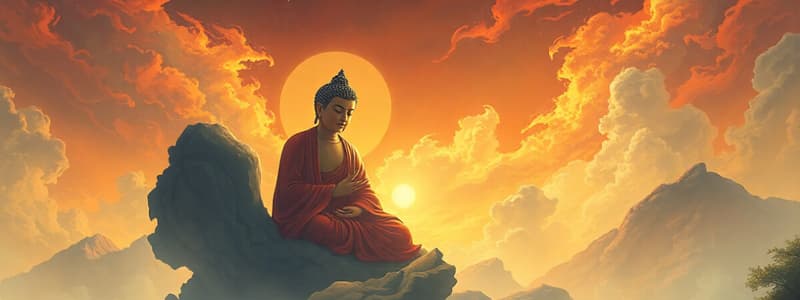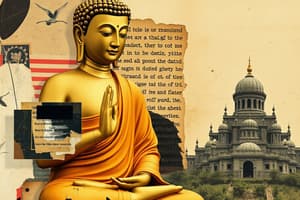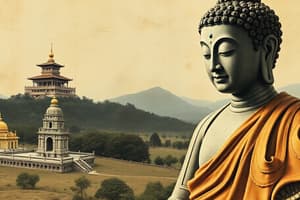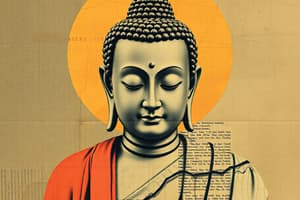Podcast
Questions and Answers
What does bathing the Buddha symbolize?
What does bathing the Buddha symbolize?
- A ritual for good fortune
- Purification of body, speech, and thoughts (correct)
- Offering of food to the monks
- Celebration of Buddha's birth
Which actions are performed during the ritual of bathing the Buddha?
Which actions are performed during the ritual of bathing the Buddha?
- Praying silently and burning sage
- Walking around the altar and singing hymns
- Kneeling, pouring water, and chanting (correct)
- Offering food and lighting incense
What is the significance of the three washes during the bathing of the Buddha?
What is the significance of the three washes during the bathing of the Buddha?
- To represent the three marks of existence
- To purify the mind and cultivate merits (correct)
- To symbolize the stages of life
- To honor the three jewels of Buddhism
Where was the Buddha born?
Where was the Buddha born?
What did Buddha do immediately after his birth, according to tradition?
What did Buddha do immediately after his birth, according to tradition?
What is a key characteristic of Buddhism regarding the concept of divinity?
What is a key characteristic of Buddhism regarding the concept of divinity?
Which branch of Buddhism is known for its compassionate view of bodhisattvas?
Which branch of Buddhism is known for its compassionate view of bodhisattvas?
What is the approximate percentage of the world population that practices Buddhism?
What is the approximate percentage of the world population that practices Buddhism?
Which branch of Buddhism is considered the oldest?
Which branch of Buddhism is considered the oldest?
What concept does Buddhism promote related to the cycle of life?
What concept does Buddhism promote related to the cycle of life?
Which country is primarily associated with the Theravada branch of Buddhism?
Which country is primarily associated with the Theravada branch of Buddhism?
What is the primary goal of Buddhism as indicated by its teachings?
What is the primary goal of Buddhism as indicated by its teachings?
What is one of the significant practices in Buddhism?
What is one of the significant practices in Buddhism?
What was the significance of the white elephant in Siddhartha's mother's dream?
What was the significance of the white elephant in Siddhartha's mother's dream?
What event led Siddhartha to leave the palace?
What event led Siddhartha to leave the palace?
What does the concept of Nirvana signify in Buddhism?
What does the concept of Nirvana signify in Buddhism?
What did Siddhartha conclude while practicing asceticism in the forest?
What did Siddhartha conclude while practicing asceticism in the forest?
Which statement best reflects a key teaching of Buddhism?
Which statement best reflects a key teaching of Buddhism?
What role did King Ashoka play in the spread of Buddhism?
What role did King Ashoka play in the spread of Buddhism?
What is the central belief of the Middle Way in Buddhism?
What is the central belief of the Middle Way in Buddhism?
In which regions is Theravada Buddhism primarily practiced?
In which regions is Theravada Buddhism primarily practiced?
What are the three sections of the Tripitaka known as?
What are the three sections of the Tripitaka known as?
Which of the following best describes the content of the Diamond Sutra?
Which of the following best describes the content of the Diamond Sutra?
How many precepts are established for monks according to the Tripitaka?
How many precepts are established for monks according to the Tripitaka?
What is a significant aspect of the Lotus Sutra?
What is a significant aspect of the Lotus Sutra?
Who were the primary disciples responsible for recording Buddha's teachings during the First Buddhist Council?
Who were the primary disciples responsible for recording Buddha's teachings during the First Buddhist Council?
Which term refers to the Buddhist community that takes refuge alongside the Buddha and Dharma?
Which term refers to the Buddhist community that takes refuge alongside the Buddha and Dharma?
What is emphasized in the sutras regarding the nature of suffering?
What is emphasized in the sutras regarding the nature of suffering?
Which of the following variants of Buddhism is associated with the idea of practicing the teachings of Buddha mainly in a community setting?
Which of the following variants of Buddhism is associated with the idea of practicing the teachings of Buddha mainly in a community setting?
What system divides individuals in society based on their birth in India?
What system divides individuals in society based on their birth in India?
Which of the following is a main belief in Hinduism?
Which of the following is a main belief in Hinduism?
What distinguishes Buddhism's view on enlightenment from Hinduism?
What distinguishes Buddhism's view on enlightenment from Hinduism?
Why did the caste system continue to be prevalent in India after it was banned in 1950?
Why did the caste system continue to be prevalent in India after it was banned in 1950?
Which of these is NOT a characteristic of Hinduism compared to Buddhism?
Which of these is NOT a characteristic of Hinduism compared to Buddhism?
What aspect does not significantly influence individuals' lives under the caste system?
What aspect does not significantly influence individuals' lives under the caste system?
Which form of worship is common in Hinduism?
Which form of worship is common in Hinduism?
What major concept connects multiple deities in Hinduism?
What major concept connects multiple deities in Hinduism?
Which concept does Buddhism share with Hinduism?
Which concept does Buddhism share with Hinduism?
Who is Vishnu in Hinduism?
Who is Vishnu in Hinduism?
Study Notes
Context - Understanding Hinduism to Understand Buddhism -
- Buddhism originated in India 2,500 years ago.
- Approximately 535 million people follow Buddhism globally (8%-10% of the world's population).
- In Australia, there are around 500,000 Buddhists (2.4% of the population).
- Buddhism doesn't believe in a God, but acknowledges that reincarnation and Nirvana exist.
- Some branches of Buddhism do acknowledge angels or divine beings.
- Buddha himself instructed his followers not to worship him as a God.
- There are three main branches of Buddhism:
- Theravada (oldest, inspired by the Tipitaka, found in southeast Asia, including Sri Lanka, Cambodia, and Laos).
- Mahayana (emphasizes the compassion of bodhisattvas, enlightenment possible in one lifetime, prevalent in northeast Asia, including China, Japan, Korea, and Mongolia).
- Vajrayana (a form of Mahayana considered the fastest path to enlightenment, found in Himalayan regions and Tibet).
Prince Siddhartha Guatama -
- Siddhartha Gautama was born between the 6th and 4th centuries BCE.
- His mother dreamt of a white elephant with six tusks entering her right side, indicating the birth of either a world ruler or a Buddha.
- Siddhartha's father, King Suddhodana, and mother, Queen Maya, kept him in the palace to shield him from suffering.
- Siddhartha left the palace at the age of 29 after encountering a sick man, an aging man, and a dying man.
- He underwent a period of intense fasting and austerity, aiming to find meaning in life and achieve Nirvana, the highest state of enlightenment.
Buddhist Beliefs: 4 Noble Truths, 8-Fold Path, 3 Jewels -
-
The Four Noble Truths are fundamental to Buddhism:
- The truth of suffering (Dukkha): Life is inherently suffering.
- The truth of the origin of suffering (Samudaya): Suffering arises from attachment and desire.
- The truth of the cessation of suffering (Nirodha): Suffering can be overcome by eliminating attachment and desire.
- The truth of the path to the cessation of suffering (Magga): The Eightfold Path leads to the cessation of suffering.
-
The Eightfold Path is guidance for achieving enlightenment:
- Right Understanding
- Right Thought
- Right Speech
- Right Action
- Right Livelihood
- Right Effort
- Right Mindfulness
- Right Concentration
-
Buddhists take refuge in the Three Jewels:
- The Buddha (the teacher).
- The Dharma (the path to practice).
- The Sangha (the community).
Buddhist Beliefs: Karma, Nirvana, Annica -
- Karma: The law of cause and effect, where actions have consequences, influencing future lives.
- Nirvana: The ultimate goal in Buddhism, a state of liberation from suffering and the cycle of rebirth. It's characterized by peace, enlightenment, and freedom from desire and attachment.
- Annica (impermanence): The understanding that all things are constantly changing and impermanent.
Buddhist Sacred Texts: Tripitaka -
- Sutras contain Buddha's teachings.
- The Dharma, or the Tripitaka (Pali Canon) consists of three sections, encompassing Buddha's teachings.
- The three sections of the Tripitaka are:
- Sutta Pitaka: Discourses of the Buddha and his close disciples.
- Bidama Pitaka: Buddhist scriptures.
- Vinaya Pitaka: Monastic codes, rules, rites, and rituals.
Buddhist Symbols -
- Dharmachakra (Wheel of Dharma): Representing the Buddha's teachings.
- Lotus Flower: Symbolizing purity, enlightenment, and rebirth.
- Stupas: Dome-shaped structures that hold relics, representing Buddha's enlightenment.
- Bodhi Tree: The tree under which Buddha attained enlightenment.
- Eight Auspicious Symbols (Ashta Mangala): Representing good fortune and protection.
Buddhist Practice: Meditation / Mindfulness -
- Meditation is a core practice in Buddhism, aiming to cultivate mindfulness and awareness.
- Mindfulness involves paying attention to the present moment without judgment, fostering clarity and understanding.
- Different types of meditation include:
- Samatha-vipassana
- Vipassanā
- Walking meditation
Buddhist Festivals: Wesak -
- Wesak commemorates the birth, enlightenment, and death (Parinirvana) of the Buddha. It's a time for reflection, spiritual renewal, and celebration.
- Wesak celebrations vary in different parts of the world.
Buddhist Ethics: The 5 Precepts -
- The Five Precepts are guidelines for ethical conduct in Buddhism:
- Abstain from taking life.
- Abstain from stealing.
- Abstain from sexual misconduct.
- Abstain from false speech and lying.
- Abstain from intoxicants that cloud the mind.
Buddhist Monastic Community: Sangha -
- The Sangha is the monastic community composed of monks and nuns.
- They live a disciplined life, dedicated to studying and practicing Buddhism.
- Monks and nuns play a vital role in preserving the Dharma (teachings of Buddha) and guiding others on the path to enlightenment.
Film Study - Kundun -
- Kundun is a film by Martin Scorsese, depicting the life of the 14th Dalai Lama, Tenzin Gyatso.
Glossary -
- Arhat: An individual who has attained the highest stage of enlightenment, liberation from suffering, and no longer subject to rebirth.
- Bodhisattva: A person who has attained enlightenment but chooses to remain in the world to help others achieve enlightenment.
- Sangha: The Buddhist monastic community of monks and nuns.
- Sutra: A Buddhist scripture containing Buddha's teachings.
- Dharma: The teachings of Buddha, representing the path to enlightenment and liberation.
- Dukkha: Suffering, a fundamental concept in Buddhism.
- Nirvana: The ultimate goal in Buddhism, a state of liberation from suffering and the cycle of rebirth.
- Samsara: The cycle of birth, death, and rebirth.
- Brahman: The ultimate reality in Hinduism, a concept representing the universal consciousness or the divine essence of the universe.
- Moksha: Liberation from the cycle of rebirth in Hinduism.
Studying That Suits You
Use AI to generate personalized quizzes and flashcards to suit your learning preferences.
Related Documents
Description
Explore the origins and evolution of Buddhism, which began in India over 2,500 years ago. This quiz covers the key teachings, major branches, and the unique beliefs that distinguish Buddhism from other religions. Test your knowledge about the followers and practices of Buddhism across the globe.




